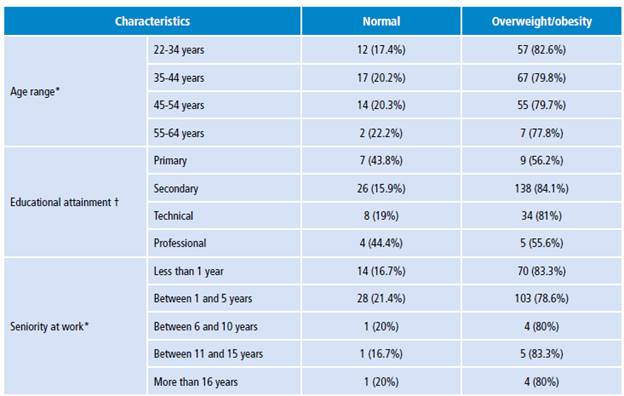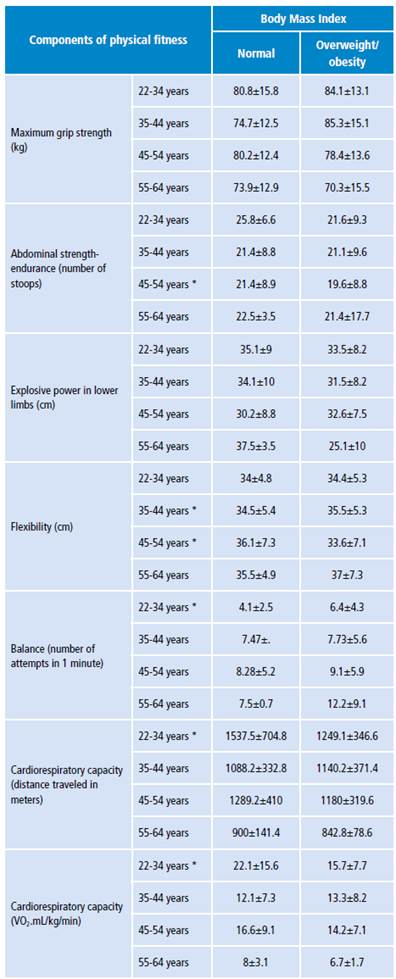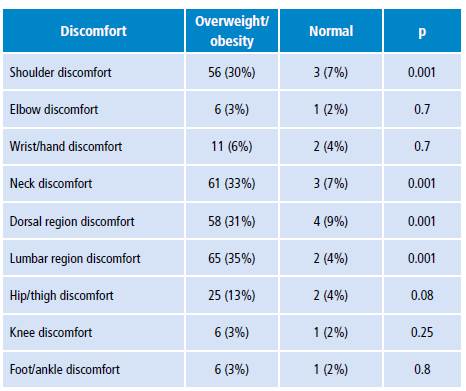Introduction
Overweight and obesity are one of the main cardiovascular risk factors that affect a large proportion of the working population. 1 The increase of their incidence is a major public health problem that alters health and the full enjoyment of a healthy and safe working life. 2 Particularly, the working conditions of drivers are associated with sedentary behaviors, which, together with overweight, obesity and unhealthy lifestyles such as low levels of physical activity and consumption of foods rich in calories, increase the occurrence of chronic non-communicable diseases. 3,4
It has been reported that 50% of truck drivers are overweight and about 30% are obese. 3 The prevalence of overweight and obesity accounted for 3.4 million deaths in 2010, a figure that is increasing in many countries, thus making this problem a global pandemic. 4 For example, in Mexico they occur in both sexes, in percentages ranging between 47.7% and 42.6%, respectively. 2 Also, this public health issue is common in people with sedentary work activities; a study conducted in bus drivers from Cali, Colombia, found that 50.7% of the participants were overweight and 36%, obese. 5
Previous studies report an incidence of overweight or obesity of 74% in heavy vehicle drivers and suggest that it is difficult to achieve and maintain a healthy lifestyle that contributes to adequate body weight due to the sedentary nature of this type of work. 6 Overweight and obesity cause mechanical overload, which linked to a static posture for a prolonged period of time, long working hours, inadequate postural care and factors related to environmental conditions such as noise, temperature, vibration, among others 7, trigger musculoskeletal symptoms and work-related diseases in drivers 8, with negative repercussions on productivity and growth of organizations. 9
Although overweight and obesity are not an occupational disease, they do affect a person's ability to work because of their correlation with low levels of physical fitness and, therefore, with the skills to carry out work activities. 10 Thus, when reviewing previous studies on the subject population of this study, it was evident that there is little research on the influence of increased body weight on physical fitness and on the presence of musculoskeletal discomfort in urban transport drivers in Colombia. Given that work environments -long working hours and sedentary behaviors- can contribute to the increase of obesity in workers 11, the surveillance and monitoring of health conditions in work environments that favor the development of a culture of well-being at work is a priority. Bearing this in mind, the purpose of this research was to determine physical fitness and musculoskeletal discomfort according to the body mass index (BMI) of urban transport drivers from Barranquilla, Colombia.
Materials and methods
Study design
Cross-sectional, analytical study carried out in response to the concern of the human talent management office of two urban transport companies regarding the increase of absenteeism due to musculoskeletal disorders in drivers.
Study population
The population included 231 drivers of two urban transport companies from Barranquilla. All workers who at the time of the study had employment contracts with these organizations were involved in the study. All subjects had a fixed-term contract for 12 months, with benefits including monthly salary, payment of premiums, layoffs, overtime, holidays, social security payment (health, retirement pension and occupational risks) and family compensation funds. Working hours ranged from 8 to 10 hours a day divided into 2 shifts of 4 hours; the workday began at 4:30 am and could end at 10:00 or 11:00 pm. The minimum travel time was 1 hour and 40 minutes, and the maximum was 2 hours and 30 minutes, round trip. Data collection took place between February 2016 and March 2017.
Variables
A survey was applied to inquire about sociodemographic variables such as sex, age, educational attainment and seniority in the company. The AFISAL-INEFC test battery was applied, as it has acceptable intra-observer test-retest reliability indices (ICC=0.76-0.99); it has been used in healthy Colombian adult population and assesses the most relevant health-related physical fitness factors such as cardiorespiratory capacity, muscle performance (strength, power and endurance), flexibility and body composition. 12
Six AFISAL-INEFC tests were administered. The Rockport Test or Mile test was applied to evaluate cardiorespiratory capacity; the participant walked a distance of 2km as fast as possible and, based on the results, the distance traveled in meters and the maximum volume of oxygen (VO2 max) were estimated. The hand-held dynamometry test was used to evaluate maximum grip strength. The trunk-curls test measures abdominal muscular endurance. The vertical jump test evaluates the explosive power of the lower limbs. The seat-and-reach test or anterior trunk flexion test with hands touching the feet was used to measure flexibility. Finally, the monopodal static balance test without vision was applied. According to the normative values of the AFISAL- INEFC battery, physical fitness must be evaluated based on the following age groups: 18 to 24 years, 25 to 34, 35 to 44, 45 to 54, 55 to 64 and >65. 13
The Nordic Questionnaire, an instrument designed and validated by Kuorinka et al., was also used. (14) It has 10 questions and seeks to establish the presence of musculoskeletal symptoms in nine body regions: neck, shoulders, upper back, elbows, wrists/hands, lower back, hips/thighs, knees and ankles/feet. This instrument also inquires about duration of the discomfort, the need to change jobs, the presence of discomfort in the last 12 months, the duration of each episode, limitations for working in the last 12 months and whether the driver has received treatment for the discomfort. Within the framework of this study, the question about the presence of musculoskeletal symptoms, discomfort or pain during the 7 days prior to the study was analyzed and each subject answered Yes or No.
A Kramer measuring rod was used to measure height in centimeters; the driver was barefoot, erect, back to wall, feet together, heels against the rod, straight knees and head with eyes at the same height as ears; height was measured during inspiration. The weight was measured with a BC-585 Fitscan Tanita scale; the participants were barefoot with light clothes on, and got on the scale with their arms at their sides and without moving. The BMI categories of the World Health Organization were taken into account; they consider that a person with values of <20 kg/m2 is thin, 20-24.9 kg/m2 is normal, 25-29.9 kg/m2 is overweight, and 30 kg/m2 is obese. 15
Procedures
The measurement of each of the variables included in this study was carried out at the company's facilities in the morning, before the working shift begun. A space was adapted according to the needs of the tests.
Statistical analysis
The statistical program SPSS version 24 (licensed by Universidad Simón Bolívar de Barranquilla) was used for the analysis of the data set. The results are presented in absolute and relative frequencies for the categorical variables and in means and standard deviations for the quantitative variables. Differences in physical fitness and perception of musculoskeletal discomfort among drivers with thin/normal BMI and overweight/obese drivers were determined with the t-Student and the χ2 statistical tests. Statistical significance was p<00.5.
Ethical considerations
This study was approved by the Research Ethics Committee of the Physiotherapy Program of Universidad Simón Bolívar through Minutes No. 0016 of November 25, 2015. Prior to the application of the assessment instruments, participants signed the informed consent. The ethical principles for human research were followed as established in the Declaration of Helsinki 16 and according to Resolution 8430 of 1993 of the Ministry of Health of Colombia, article 11. 17 This research was considered of minimal risk because it is a prospective study in which the subject was weighed and moderate physical activity was used in healthy volunteers.
Results
All the drivers were men. When comparing socio-demographic characteristics and BMI, higher percentages of drivers in all age ranges with excess weight were observed, although there was a higher frequency of overweight/obesity (82.6%) in workers between 22 and 34 years of age (Table 1). Among workers between 1 and 5 years and 11 and 15 years of seniority in the company, the frequency of overweight/obesity was higher. The mean age was 39.9±8.5 years, the minimum age was 22 years and the maximum age was 61 years. Overall, 68 drivers (29.4%) were obese and 118 (51.1%) were overweight. In terms of BMI, the mean in the general population was 28.5±4.3 kg/m2.
Table 1 Sociodemographic and anthropometric characteristics of participating drivers.

* p>0.05 t p<0.05
Source: Own elaboration.
When comparing physical fitness among subjects with different BMI, Table 2 shows that there were significant differences (p=0.04) in the values of abdominal strength and endurance in drivers aged between 45 and 54 years. People with normal BMI averaged 21.4±8.9 in stooped exercises and people with overweight and obesity had an average of 19.6±8.8 repetitions. Flexibility also showed differences (p=0.02) in people aged 45-54 with overweight and obesity; the mean score was 33.6±7.1cm compared to the mean of 36.1±7.3cm of those with normal BMI.
Table 2 also exposes the significant differences in aerobic capacity in people under 30 years of age. The distance traveled by overweight and obese people was 1 249.1±346.6m and 1 537.5±704.8m in people with normal BMI (p=0.000). The maximum oxygen consumption was lower (15.7±7.7 mL/kg/min) in overweight and obese drivers.
Table 3 shows an increased frequency of musculoskeletal discomfort in subjects with BMI >25 kg/m2. The body regions with the greatest perception of symptoms by drivers in the last 7 days were the lumbar, cervical and dorsal spine, and shoulders (p<0.05).
Discussion
The results reported here show high frequencies of overweight and obesity in the study population, perhaps due to the sedentary nature of their job and the scarce opportunity for physical activity in leisure time due to long working hours; these risks expose them to developing chronic diseases. 9
It was observed that in drivers with more years of service in the company, the proportion of overweight and obesity was also higher; these results coincide with those of Camargo et al.5, who claim that the average time of performance in the driver's trade was significantly associated with cardiovascular risk factors.
Although no statistical differences were found between BMI and maximum grip strength before age 45, people with BMI >25 kg/m2 have greater strength, as opposed to those over 45 years where overweight and obese people had less grip strength than normal weight people. Other authors state that, in healthy people, age influences grip strength (18,19) as a negative relationship between them has been reported (r= -0.42, p<0.001), with a decrease of 0.25 kg per year of age. Reduced muscle strength in overweight and obese people can be explained by high levels of inactivity, a factor that contributes to reduced muscle performance. 18
Regarding flexibility, overweight and obese drivers showed levels higher than normal parameters, unlike the study by Rioux et al.20, in which obese men achieved an average of -7cm, being much less than the results found in this research. On the other hand, the distance traveled and the maximum oxygen consumption, as defined during the Submaximal 2-km treadmill test, in overweight and obese subjects was lower in overweight and obese subjects than in those with normal BMI. These findings have also been reported in other studies, where people with a BMI >25.3 kg/m2 have very low exercise tolerance due to altered cardiopulmonary function caused by an increased fat mass that interferes with the aerobic response to physical exertion. 21,22
Modifiable risk factors, overweight, obesity and sedentary lifestyle expose the drivers to chronic non-communicable diseases, a condition that is reversed with high levels of physical activity. Other authors suggest that good cardiorespiratory fitness modifies the correlation between higher BMI and all-cause mortality 23, and that good physical fitness alters the obesity paradox, because BMI >25 can protect against premature mortality if the person has good physical fitness. 24
This study also found that overweight and obesity are associated with musculoskeletal disorders such as low back pain, a result reported by other authors as well. 25,26 In the study by Hussain et al.25 a similar phenomenon between the ratio of BMI and low-back pain was found: higher levels of low-back pain were found in adult subjects with elevated BMI, while subjects with low BMI did not present these symptoms. Another study on work-related stress in heavy vehicle drivers of a transport company found that 93.3% of the workers had suffered from some type of muscle tension that had in turn caused them musculoskeletal disorders, headaches and tiredness. 27
Bus drivers are exposed to several factors that put them at risk for low back pain, including a sedentary lifestyle, poor physical fitness, and overweight/obesity, which in turn increase biomechanical disorders and muscle imbalance and, consequently, exert greater compressive force on the structures of the lumbar spine. 28 As could be established in this study, the health conditions of drivers can be altered by high levels of inactivity required by the workplace; for this reason, implementing actions that enable them to improve their healthy lifestyles is imperative. This is consistent with the National Plan for Safety and Health Conditions at Work 2013-2021 29, which set as one of its objectives to promote research for the early detection of risks to the health of workers and the implementation of timely interventions to reduce the incidence of occupational diseases.
Conclusions
Overweight is a prevalent condition in the study population (drivers), as well as lower aerobic capacity and more frequent musculoskeletal discomfort.
The limitation of this study is its cross-sectional design, which does not allow establishing causal inferences; however, etiologic hypotheses were generated that encourage further research with more robust designs and, most importantly, provide guidance for making relevant public health decisions.

















